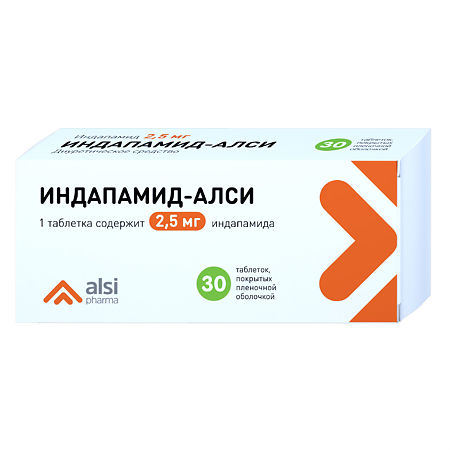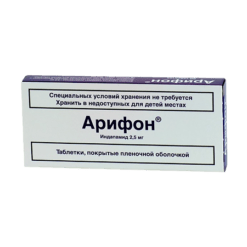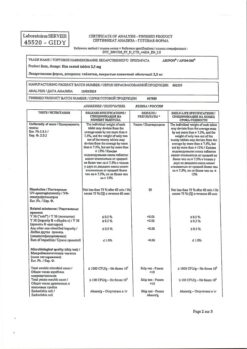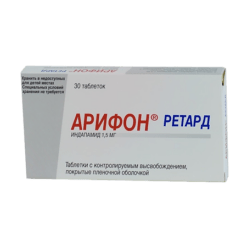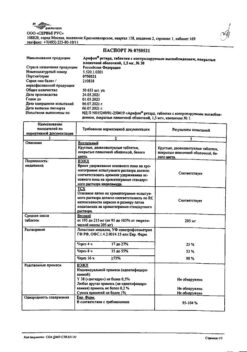No products in the cart.
Indapamide-ALSI, 2.5mg 30 pcs
€0.88 €0.73
Out of stock
(E-mail when Stock is available)
Description
Hypotensive agent, thiazide-like diuretic of moderate potency and long duration of action, benzamide derivative. It has moderate saluretic and diuretic effects, which are associated with blockade of reabsorption of sodium, chloride, hydrogen and, to a lesser extent, potassium ions in proximal tubules and cortical segment of distal tubule of nephron.
The vasodilatory effects and reduction of total peripheral vascular resistance have in their basis the following mechanisms: reduction of reactivity of the vascular wall to noradrenaline and angiotensin II; increased synthesis of prostaglandins with vasodilatory activity; inhibition of calcium flow in vascular smooth muscle walls.
Limits the tone of arterial smooth muscle, reduces total peripheral vascular resistance. Helps reduce left ventricular hypertrophy. In therapeutic doses does not affect lipid and carbohydrate metabolism (including in patients with concomitant diabetes).
The antihypertensive effect develops at the end of the first/beginning of the second week with continued use and lasts for 24 hours with a single dose.
Indications
Indications
Arterial hypertension
Pharmacological effect
Pharmacological effect
Antihypertensive drug, thiazide-like diuretic with moderate strength and long-lasting action, benzamide derivative. It has moderate saluretic and diuretic effects, which are associated with blockade of the reabsorption of sodium, chlorine, hydrogen, and to a lesser extent potassium ions in the proximal tubules and the cortical segment of the distal tubule of the nephron.
Vasodilating effects and a decrease in total peripheral vascular resistance are based on the following mechanisms: a decrease in the reactivity of the vascular wall to norepinephrine and angiotensin II; increased synthesis of prostaglandins with vasodilatory activity; inhibition of calcium flow into the smooth muscle walls of blood vessels.
Reduces the tone of the smooth muscles of the arteries, reduces the total peripheral vascular resistance. Helps reduce hypertrophy of the left ventricle of the heart. In therapeutic doses it does not affect lipid and carbohydrate metabolism (including in patients with concomitant diabetes mellitus).
The antihypertensive effect develops at the end of the first/beginning of the second week with continuous use of the drug and persists for 24 hours with a single dose.
Special instructions
Special instructions
With long-term use or when taking Indapamide in large doses, electrolyte disturbances such as hyponatremia, hypokalemia, and hypochloremic alkalosis may develop. These disorders are more often observed in patients with chronic heart failure (functional class II-IV, according to the NYHA classification); liver diseases, vomiting and diarrhea, as well as in persons on a salt-free diet.
Concomitant use of Indapamide with cardiac glycosides and corticosteroids increases the risk of hypokalemia. In addition, renal excretion of magnesium may increase, which can lead to hypomagnesemia.
Orthostatic hypotension may occur, which can be provoked by the intake of alcohol, barbiturates, narcotic drugs and the simultaneous use of other antihypertensive drugs.
In patients taking cardiac glycosides, laxatives, against the background of hyperaldosteronism, as well as in the elderly, careful monitoring of potassium and creatinine levels is indicated.
The most careful monitoring is indicated in patients with liver cirrhosis, coronary heart disease, and chronic heart failure.
The high-risk group also includes patients with an increased QT interval on the electrocardiogram (congenital or developed against the background of any pathological process). The first measurement of potassium concentration in the blood should be carried out during the first week of treatment.
Hypercalcemia during the use of Indapamide may be a consequence of previously undiagnosed hyperparathyroidism.
In patients with diabetes mellitus, it is extremely important to control blood glucose concentrations, especially in the presence of hypokalemia.
Significant dehydration can lead to the development of acute renal failure (decreased glomerular filtration rate). Patients need to compensate for fluid loss and carefully monitor renal function at the beginning of treatment.
Indapamide may give a positive result during a doping test.
Patients with arterial hypertension and hyponatremia (due to taking diuretics) should stop taking diuretics 3 days before starting ACE inhibitors (if necessary, diuretics can be resumed a little later), or use initial low doses of ACE inhibitors.
Sulfonamide derivatives can aggravate the course of systemic lupus erythematosus (must be borne in mind when using Indapamide).
Active ingredient
Active ingredient
Indapamide
Composition
Composition
One film-coated tablet contains:
Active substance:
Indapamide – 2.5 mg;
Excipients:
Pregelatinized starch – 41.8 mg
Microcrystalline cellulose – 45 mg
Colloidal silicon dioxide (Aerosil) – 0.5 mg
Magnesium stearate – 0.2 mg
Hypromellose – 1.008 mg
Macrogol – 0.36 mg
Lactose monohydrate – 1.296 mg and titanium dioxide – 0.936 mg
Contraindications
Contraindications
Hypersensitivity to indapamide, other sulfonamide derivatives or other components of the drug
Acute cerebrovascular accident
Severe renal impairment (creatinine clearance less than 30 ml/min) and/or liver (including with encephalopathy
Hypokalemia
Concomitant use of drugs that prolong the QT interval
Pregnancy
Lactation period
Age up to 18 years (efficacy and safety have not been established).
The tablet shell contains lactose; therefore, the drug should not be taken by patients with rare hereditary diseases such as galactose intolerance, lactase deficiency or glucose-galactose malabsorption.
With caution when:
Diabetes mellitus in the stage of decompensation
Hyperuricemia (especially accompanied by gout and urate nephrolithiasis)
Hyponatremia and other disorders of water and electrolyte metabolism
Moderate liver and/or renal failure
Ascites
Coronary heart disease
Chronic heart failure
Hyperparathyroidism
In weakened patients and patients with an increased QT interval on the ECG or receiving concomitant therapy with other antiarrhythmic drugs.
Side Effects
Side Effects
From the metabolic side: hypokalemia, hyponatremia, hypochloremic alkalosis, hypercalcemia, increased urea nitrogen in the blood plasma, hypercreatininemia, glycosuria, hyperuricemia, hyperglycemia.
From the digestive system: dryness of the oral mucosa, vomiting, gastralgia, anorexia, abdominal discomfort, pancreatitis, constipation or diarrhea, hepatic encephalopathy (due to liver failure).
From the central nervous system: asthenia, dizziness, nervousness, headache, drowsiness, increased fatigue, general weakness, insomnia, depression, tension, irritability, anxiety, lethargy, lethargy, agitation, paresthesia, tingling sensation in the extremities.
From the senses: conjunctivitis, visual impairment.
From the respiratory system: rhinitis, cough, pharyngitis, sinusitis.
From the cardiovascular system: orthostatic hypotension, arrhythmia, palpitations, changes in the electrocardiogram characteristic of hypokalemia.
From the urinary system: nocturia, polyuria, increased incidence of infections.
From the hematopoietic organs: thrombocytopenia, leukopenia, agranulocytosis, bone marrow aplasia, hemolytic anemia.
Allergic reactions: skin rash, itching, urticaria, hemorrhagic vasculitis.
Other: flu-like syndrome, chest pain, malaise, muscle spasms, back pain, decreased libido and potency, rhinorrhea, increased sweating, weight loss, exacerbation of systemic lupus erythematosus, cases of photosensitivity reaction have been described.
Interaction
Interaction
With simultaneous use of indapamide with lithium preparations, an increase in the concentration of lithium in the blood plasma is possible.
Astemizole, erythromycin (iv), pentamidine, sultopride, vincamine, antiarrhythmic drugs IA (quinidine, disopyramide) and class III (amiodarone, bretylium tosylate, sotalol) may increase the likelihood of heart rhythm disturbances such as torsades de pointes (ventricular tachycardia of the “pirouette” type).
Non-steroidal anti-inflammatory drugs, glucocorticosteroids, tetracosactide, sympathomimetics reduce the hypotensive effect, baclofen increases.
Saluretics, cardiac glycosides, gluco- and mineralocorticosteroids, tetracosactide, amphotericin B (iv), laxatives increase the risk of hypokalemia.
When used simultaneously with cardiac glycosides, the likelihood of developing digitalis intoxication increases, with calcium preparations – hypercalcemia, with metformin – aggravation of lactic acidosis is possible.
A combination with potassium-sparing diuretics may be effective in some categories of patients, however, the likelihood of developing hypo- or hyperkalemia is not completely excluded, especially in patients with diabetes mellitus and renal failure.
Angiotensin-converting enzyme (ACE) inhibitors increase the risk of developing arterial hypotension and/or acute renal failure (especially with existing renal artery stenosis).
Contrast agents containing iodine in high doses increase the risk of developing renal dysfunction (dehydration). Before using contrast agents containing iodine, patients need to restore fluid loss.
Tricyclic antidepressants and antipsychotic drugs enhance the hypotensive effect and increase the risk of developing orthostatic hypotension.
Cyclosporine increases the risk of developing hypercreatininemia.
Reduces the effect of indirect anticoagulants (coumarin or indanedione derivatives) due to an increase in the concentration of coagulation factors as a result of a decrease in circulating blood volume and an increase in their production by the liver (dose adjustment may be required).
Strengthens the blockade of neuromuscular transmission that develops under the influence of non-depolarizing muscle relaxants.
Overdose
Overdose
Symptoms: nausea, vomiting, weakness, dysfunction of the gastrointestinal tract, water and electrolyte disturbances, decreased blood pressure, dizziness, drowsiness, confusion, respiratory depression; in patients with impaired liver function, hepatic coma may develop.
Treatment: gastric lavage and/or administration of activated carbon followed by restoration of normal water and electrolyte balance, symptomatic therapy. There is no specific antidote.
Recommendations for use
Recommendations for use
Orally, preferably in the morning, regardless of food intake, 2.5 mg (1 tablet) per day, with a sufficient amount of liquid.
If after 4-8 weeks of treatment the desired therapeutic effect is not achieved, it is not recommended to increase the dose of the drug (the risk of side effects increases without enhancing the antihypertensive effect). Instead, it is recommended to include another antihypertensive drug that is not a diuretic in the drug treatment regimen.
In cases where treatment must be started with two drugs, the dose of Indapamide remains 2.5 mg in the morning once a day.
Functional features
Functional features
After oral administration, it is quickly and completely absorbed from the gastrointestinal tract. Bioavailability is high (93%).
Eating slightly slows down the rate, but does not affect the completeness of absorption. The maximum concentration in the blood is reached 1-2 hours after ingestion. Equilibrium concentration is achieved after 7 days of regular use.
The drug is 70-80% bound to blood plasma proteins. It has a high volume of distribution, passes through histohematic (including placental) barriers, and penetrates into breast milk. Metabolized in the liver.
The half-life of indapamide averages 14-18 hours. Excreted from the body by the kidneys (up to 80%), mainly in the form of metabolites, through the intestines – 20%. In patients with renal failure, pharmacokinetics do not change. Does not cumulate.
Storage conditions
Storage conditions
In a dry place, protected from light, at a temperature not exceeding 25ºС.
Keep out of the reach of children.
Shelf life
Shelf life
3 years. Do not use after the expiration date stated on the package.
Manufacturer
Manufacturer
ALSI Pharma, Russia
Additional information
| Shelf life | 3 years. Do not use after the expiration date stated on the package. |
|---|---|
| Conditions of storage | In a dry, light-protected place at a temperature not exceeding 25ºC. Store out of the reach of children. |
| Manufacturer | ALSI Pharma, Russia |
| Medication form | pills |
| Brand | ALSI Pharma |
Other forms…
Related products
Buy Indapamide-ALSI, 2.5mg 30 pcs with delivery to USA, UK, Europe and over 120 other countries.

